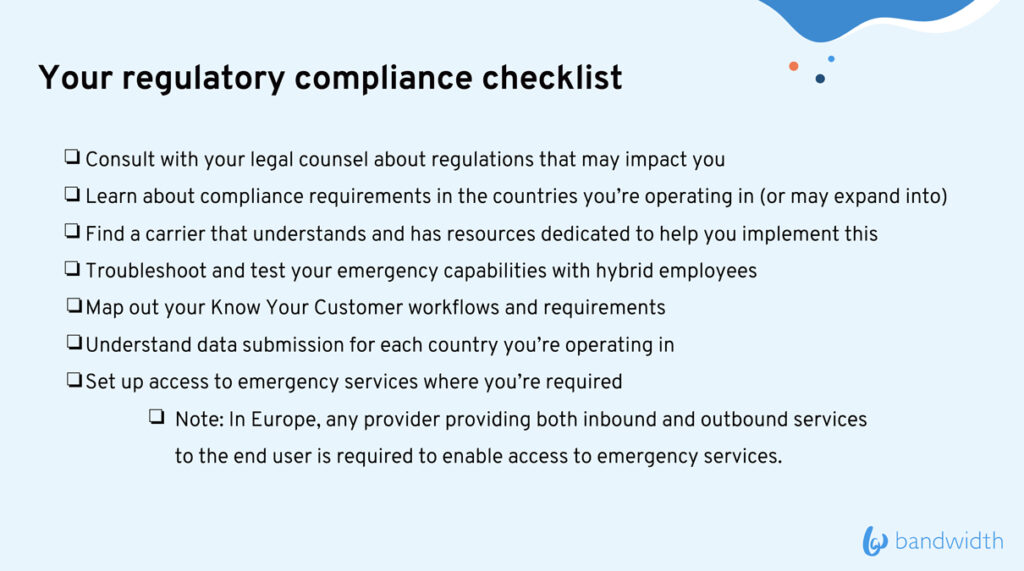Did you know that France and Germany have different rules for activating new telecom numbers? Or that emergency notification requirements vary significantly from country to country? If your organization has operations in multiple nations – or even just one location – you need to be sure your solutions meet all of that jurisdiction’s statutory requirements. Otherwise, you could face financial penalties or legal risks.
These types of telecom regulatory issues can impact many aspects of your organization’s operations, including international scalability, business continuity, emergency calling, and agent and customer experiences, according to Robin Erkkila, 911 sales engineer, Bandwidth. “Your telecom compliance approach should be proactive, rather than reactive, in order to avoid potential problems,” she said. “You should reach out to your providers and ask about their country-by-country mitigation plans.”
Telecom users and providers today face a rapidly changing regulatory environment, said Erkilla, who was one of two panelists at a recent Enterprise Connect webinar, “Regulatory Masterclass: Telecom Compliance in the U.S. and Beyond,” moderated by Eric Krapf, general manager and program co-chair, Enterprise Connect, and sponsored by Bandwidth.
“Wherever you are on your journey to the cloud, you need to be aware of the relevant regulatory environment,” added panelist Mehmet Hussein, head of international solutions for Bandwidth. “In the past few years, many organizations have had to make quick decisions on their telephony stacks. Now, you have to be sure you are complying with local requirements that pertain to telecom services.”

A time of change
The shift to cloud-based telecom platforms, coupled with the demise of ISDN networks around the world, is creating a rapidly changing environment for multinational organizations, said the panelists. These changes are in addition to data security and privacy requirements that affect the terms of use, geographic location and other rules regarding customers and employees.
Other changes are in the works as government agencies update longstanding rules originally written for ISDN service in order to reflect the new hybrid telecom environment, said Hussein. Navigating the country-by-country rules requires a granular approach, he added. For example, France has a set of rules for activating fixed and non-fixed numbers, while Germany’s activation regulations focus on regional versus national numbers. “You typically need to collect proof of address and user identity documentation and pass that on to the regulators,” Hussein said.
Emergency service notifications is another area where the regulatory landscape is changing, as some countries like Canada are adopting next-gen 911 tools, while others continue to use older technologies, Erkkila said. “The U.S. is ahead of the curve, but other nations are moving in that direction and looking a similar workflows,” she added. “But in any case, you have to provision the line and be able to route the call.”
Key recommendations
Here are several proactive steps that organizations should consider , according to the panelists.
• Unbundle procurement of services. Multinational organizations facing varying requirements, may simplify issued by separating their telecom setups into three buckets: core voice services, billing, and emergency services, Erkkila said.
• Start from the bottom. Analyze your communications stack to better understand potential regulatory vulnerabilities, she said. “Be sure your network infrastructure is compliant, then move upward to your applications and add software to bridge any compliance gaps. In some cases, you may need to update your solutions to comply with new requirements.”
• Team up with your legal department. Create an IT/legal team or task force to learn about data and telecom compliance requirements in the countries where you operate.
Because complying with multiple legal and regulatory requirements requires IT resources, Erkkila suggested engaging a consultant to review your current infrastructure and manage the country-by-country compliance process. “You don’t have to be an expert on this,” she said. “Find an expert who can guide you through the regulatory maze.”